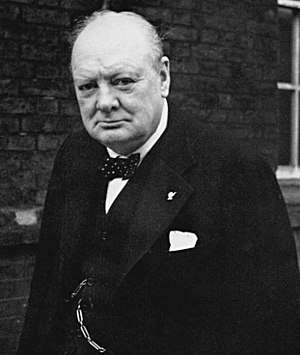Lady Randolph Churchill
| Jennie Spencer-Churchill | |
|---|---|
| Lady Randolph Spencer-Churchill | |
_(B).jpg) Portrait of Lady Randolph Churchill, c. 1880 | |
| Born |
Jennie Jerome 9 January 1854 Cobble Hill, Brooklyn, New York, U.S. |
| Died |
29 June 1921 (aged 67) Paddington, London, England |
| Buried | St Martin's Church, Bladon |
| Spouse(s) |
|
| Issue | |
| Father | Leonard Jerome |
| Mother | Clarissa Hall |
Jennie Spencer-Churchill CI RRC DStJ (née Jerome; 9 January 1854 – 29 June 1921), known as Lady Randolph Churchill, was an American-born British socialite, the wife of Lord Randolph Churchill and the mother of British Prime Minister Sir Winston Churchill.
Early life
Jennie[1] Jerome was born in the Cobble Hill section of Brooklyn in 1854,[2] the second of four daughters (one died in childhood) of financier, sportsman, and speculator Leonard Jerome and his wife Clarissa (always called Clara[3]), daughter of Ambrose Hall, a landowner. She was raised in Brooklyn, Paris, and New York City. She had two surviving sisters, Clarita (1851–1935) and Leonie (born 1859). Another sister, Camille (1855–1863) died when Jennie was nine.[4]
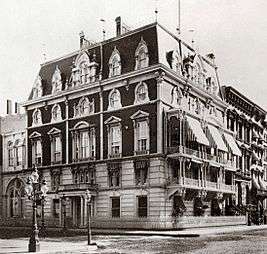
There is some disagreement regarding the time and place of her birth. A plaque at 426 Henry St. gives her year of birth as 1850, not 1854. However, on 9 January 1854, the Jeromes lived nearby at number 8 Amity Street (since renumbered as 197). It is believed that the Jeromes were temporarily staying at the Henry Street address, which was owned by Leonard's brother Addison, and that Jennie was born there during a snowstorm.[5]
A noted beauty (an admirer, Lord d'Abernon, said that there was "more of the panther than of the woman in her look"[6]), Jennie Jerome worked as a magazine editor in early life. Hall family lore insists that Jennie had Iroquois ancestry, through her maternal grandmother;[7] however, there is no research or evidence to corroborate this.[8]
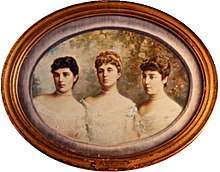
Personal life
Lady Randolph was a talented amateur pianist, having been tutored as a girl by Stephen Heller, a friend of Chopin. Heller believed that his young pupil was good enough to attain 'concert standard' with the necessary 'hard work', of which, according to author Mary S Lovell, he was not confident she was capable.[9]
Randolph served as the chair of the hospital committee for the American Women's War Relief Fund starting in 1914.[10][11] This organization helped fund and staff two hospitals during World War I.[12]
First marriage
_(A).jpg)
Jennie Jerome was married for the first time on 15 April 1874, aged 20, at the British Embassy in Paris, to Lord Randolph Churchill, the third son of John Winston Spencer-Churchill, 7th Duke of Marlborough and Lady Frances Anne Vane.[13] The couple had met at a sailing regatta on the Isle of Wight in August 1873, having been introduced by the Prince of Wales, the future King Edward VII.[14] Although they became engaged within three days of this initial meeting, the marriage was delayed for months while their parents argued over settlements.[15] By this marriage, she was properly known as Lady Randolph Churchill and would have been addressed in conversation as Lady Randolph.
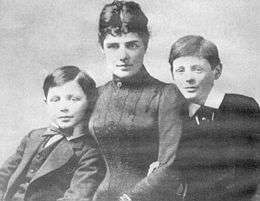
The Churchills had two sons: Winston (1874–1965), the future prime minister, was born less than eight months after the marriage. According to his biographer William Manchester, Winston was most likely conceived before the marriage, rather than born prematurely. A recent biography has stated that he was born two months prematurely after Lady Randolph "had a fall."[16] When asked about the circumstances of Winston's birth, Jennie replied: "Although present on the occasion, I have no clear recollection of the events leading up to it."[15] Lady Randolph's sisters believed that the biological father of the second son, John (1880–1947) was Evelyn Boscawen, 7th Viscount Falmouth.[17] although most discredited that due to the boys striking likeness to their father and each other.
Lady Randolph is believed to have had numerous lovers during her marriage, including Karl Kinsky, the Prince of Wales (the future King Edward VII), and Herbert von Bismarck.[18]
As was the custom of the day in her social class, Lady Randolph played a limited role in her sons' upbringing, relying largely upon nannies, especially Elizabeth Everest. Winston worshipped his mother, writing her numerous letters during his time at school and begging her to visit him, which, however, she rarely did. He wrote about her in My Early Life: 'She shone for me like the evening star. I loved her dearly – but at a distance'.[19] After he became an adult, they became good friends and strong allies, to the point where Winston regarded her almost as a political mentor, more as a big sister than as a mother. She was well-respected and influential in the highest British social and political circles. She was said to be intelligent, witty, and quick to laughter. It was said that Queen Alexandra especially enjoyed her company, although Jennie had been involved in an affair with her husband, the king, which was well known to Alexandra.[20] Through her family contacts and her extramarital romantic relationships, Jennie greatly helped Lord Randolph's early career, as well as that of her son Winston. In 1909 when American impresario Charles Frohman became sole manager of The Globe Theatre, the first production was His Borrowed Plumes, written by Lady Randolph Churchill. Although Mrs Patrick Campbell produced and took the lead role in the play, it was a commercial failure. It was at this point that Campbell began an affair with Lady Randolph's then husband, George Cornwallis-West.[21]
Later marriages
Lord Randolph died in 1895, aged 45. His death freed Jennie to move effortlessly in spite of her impecuniosity; she mixed in the highest London society circles, and was much admired by the Prince of Wales. Attending a party hosted by Daisy Warwick, Jennie was introduced to George Cornwallis-West, who was just 26 days older than Winston; he was instantly smitten, and they spent much time together. A captain in the Scots Guards, George had two sisters: Constance (known as Shelagh) was the first wife of the 2nd Duke of Westminster; Daisy was married to the Prince of Pless. George and Jennie were married on 28 July 1900 at St Paul's Church, Knightsbridge.[22]
Around this time, Jennie became well-known for chartering the hospital ship RFA Maine to care for those wounded in the Second Boer War, for which she was awarded the decoration of the Royal Red Cross (RRC) in the South Africa Honours list published on 26 June 1902.[23] She received the decoration in person from King Edward VII on 2 October that year, during a visit to Balmoral Castle.[24] In 1908, she wrote her memoirs The Reminiscences of Lady Randolph Churchill. George doted on Jennie, amorously nicknaming her "pussycat". However, they drifted apart. The Churchills were becoming a dedicated literary family, and George, who was a financial failure in the City, slowly fell out of love with his wife, who was old enough to be his mother. Short of money, Jennie contemplated selling the family home in Hertfordshire to move into the Ritz Hotel in Piccadilly. George was in fragile health when he recuperated at the royal skiing resort of St Moritz. Jennie took to writing plays for the West End, in many of which the star was Mrs. Patrick Campbell.
Jennie separated from George in 1912, and they were divorced in April 1914, whereupon, in a bit of irony, Cornwallis-West married Mrs. Campbell. Jennie dropped the surname Cornwallis-West, and resumed, by deed poll, the name Lady Randolph Churchill.[25]
Her third marriage, on 1 June 1918, was to Montagu Phippen Porch (1877–1964), a member of the British Civil Service in Nigeria, who was younger than Winston by three years. At the end of World War I, Porch resigned from the colonial service. After Jennie's death, he returned to West Africa, where his business investments had proven successful.[26]
Death
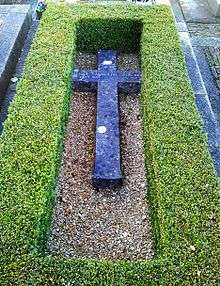
In May 1921, while Montagu Porch was away in Africa, Jennie slipped while coming down a friend's staircase wearing new high-heeled shoes, breaking her ankle. Gangrene set in, and her left leg was amputated above the knee on 10 June. She died at her home at 8 Westbourne Street in London on 29 June, following a haemorrhage of an artery in her thigh (resulting from the amputation). She was 67 years old.[27][28]
She was buried in the Churchill family plot at St Martin's Church, Bladon, Oxfordshire, next to her first husband.
Legacy
According to legend, Jennie Churchill was responsible for the invention of the Manhattan cocktail. She allegedly commissioned a bartender for a special drink to celebrate the election of Samuel J. Tilden to the New York governorship in 1874. While the drink is believed to have been invented by the Manhattan Club (an association of New York Democrats) on that occasion, Jennie could not have been involved, as she was in Europe at the time, about to give birth to her son Winston later that month.[29]
Jennie Churchill was portrayed by Anne Bancroft in the film Young Winston (1972), by Lee Remick in the British television series Jennie: Lady Randolph Churchill (1974), and by Olivia Williams in the film Victoria and Abdul (2017). She was also portrayed by Margaret Ann Bain in dramatic re-enactments during the 2009 Channel 4 documentary Lady Randy: Churchill's Mother.
Gallery
| Wikimedia Commons has media related to Jennie Churchill. |
_(A).jpg) Lady Randolph Churchill. The photograph is signed by the model.
Lady Randolph Churchill. The photograph is signed by the model._(C).jpg) Jennie Spencer-Churchill circa 1885
Jennie Spencer-Churchill circa 1885_(E).jpg) Jennie Spencer-Churchill photographed in 1889
Jennie Spencer-Churchill photographed in 1889 Photograph by Henry Van der Weyde (1838–1924)
Photograph by Henry Van der Weyde (1838–1924)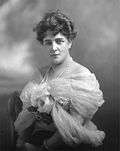 Lady Randolph Churchill in December 1899
Lady Randolph Churchill in December 1899
See also
- The Anglo-Saxon Review, a quarterly miscellany edited by Lady Randolph Churchill
References
- ↑ Her legal name was Jennie, per the 1874 marriage license bearing witness to her union with Lord Randolph Spencer-Churchill, accessed on ancestry.com on 21 January 2017.
- ↑ G. H. L. Le May, "Churchill, Jeanette [Lady Randolph Churchill] (1854–1921)", rev. Oxford Dictionary of National Biography, Oxford University Press, 2004; online ed., May 2006, accessed 18 September 2010
- ↑ Lovell, Mary (2011). The Churchills in Love And War. New York: W. W. Norton & Company. p. 24. ISBN 978-0-393-06230-4.
- ↑ Anne Saba, American Jennie, Norton, 2008, page 13
- ↑ "Winston Churchill's Mother Jennie Jerome Was Born in Cobble Hill, But in Which House?". Cobble Hill Association. 15 June 2011. Archived from the original on 30 January 2012. Retrieved 24 February 2012.
- ↑ Lovell, Mary (2011). The Churchills in Love And War. New York: W. W. Norton & Company. p. 65. ISBN 978-0-393-06230-4.
- ↑ Ralph G. Martin Jennie: The Life of Lady Randolph Churchill—The Romantic Years, 1854–1895, 9th printing, 1969
- ↑ "Churchill Had Iroquois Ancestors". Winstonchurchill.org. 29 June 1921. Retrieved 30 August 2015.
- ↑ Lovell, Mary S., The Churchills, Little Brown, London, 2011, p.28.
- ↑ "Work of American Women's War Relief Fund in London". New York Herald. 31 December 1916. Retrieved 2018-04-26 – via Newspapers.com.
- ↑ "Two Hospitals for U.S. Troops Wounded". Salisbury Evening Post. 20 June 1917. Retrieved 2018-04-27 – via Newspapers.com.
- ↑ "Helping in Britain: The American Women's War Relief Fund". American Women in World War I. 2017-01-09. Archived from the original on 27 September 2017. Retrieved 2018-04-26.
- ↑ Anita Leslie. Jennie: The Life of Lady Randolph Churchill, 1969
- ↑ Library of Congress 'Churchill and the Great Republic' exhibition notes
- 1 2 William Manchester, The Last Lion, ISBN 0-440-54681-8
- ↑ Johnson, Paul (2010). Churchill. New York, NY: Penguin. p. 4. ISBN 0143117998.
- ↑ Anne Sebba, American Jennie: The Remarkable Life of Lady Randolph Churchill", Norton, 2008
- ↑ Manchester, William, Winston Spencer Churchill, The Last Lion, Laurel, Boston, 1989 edition, p. 137, ISBN 0-440-54681-8.
- ↑ Churchill, Winston, My Early Life, 1930, Touchstone, 1996 edition, p.28.
- ↑ "Edward VII". Archived from the original on 27 October 2009. Retrieved 2007-10-18.
- ↑ Lovell, Mary S., The Churchills, Little Brown, London, 2011, p.259.
- ↑ MacColl, Gail; Wallace, Carol McD. (2012). To Marry an English Lord: Tales of Wealth and Marriage, Sex and Snobbery. New York: Workman Publishing. p. 364. ISBN 9780761171959. OCLC 883485021.
- ↑ "No. 27448". The London Gazette (Supplement). 26 June 1902. p. 4193.
- ↑ "Court Circular". The Times (36889). London. 3 October 1902. p. 7.
- ↑ "No. 28820". The London Gazette. 10 April 1914. p. 3130.
- ↑ Lovell, Mary S., The Churchills, Little Brown, London, 2011, p.332, ISBN 978-1-4087-0247-5.
- ↑ Jenkins, Roy., Churchill, Pan Books, London, 2002 edition, pp.353–354, ISBN 0-330-48805-8.
- ↑ "Index entry". FreeBMD. ONS. Retrieved 10 October 2017.
- ↑ "Jennie and the Manhattan". The New York Times. 23 December 2007. Retrieved 24 February 2012.
Further reading
- Churchill, Lady Randolph Spencer. The Reminiscences of Lady Randolph Churchill, 1908 (Autobiography)
- Leslie, Anita. Jennie: The Life of Lady Randolph Churchill, 1969
- Martin, Ralph G.. Jennie: The Life of Lady Randolph Churchill – The Romantic Years, 1854–1895 (Prentice-Hall, Ninth printing, 1969)
- Martin, Ralph G.. Jennie: The Life of Lady Randolph Churchill – Volume II, The Dramatic Years, 1895–1921 (Prentice-Hall, 1971) ISBN 0-13-509760-6
- Martin, Ralph G.. Reissue of both volumes of Jennie: The Life of Lady Randolph Churchill, (Sourcebooks, 2007) ISBN 978-1-4022-0972-7
- Sebba, Anne. American Jennie: The Remarkable Life of Lady Randolph Churchill (W.W. Norton, 2007) ISBN 0-393-05772-0
External links
| Simple English Wikiquote has a collection of quotations related to: Lady Randolph Churchill |
